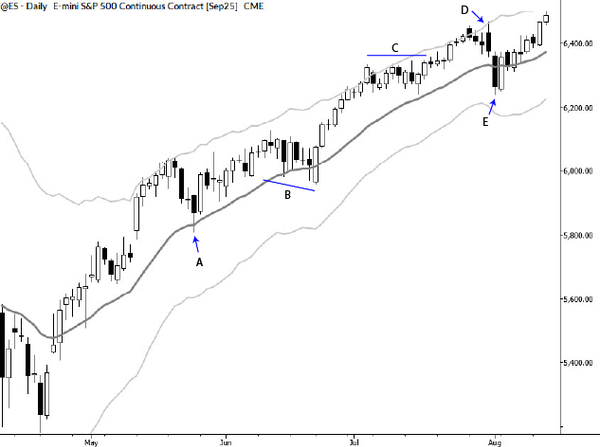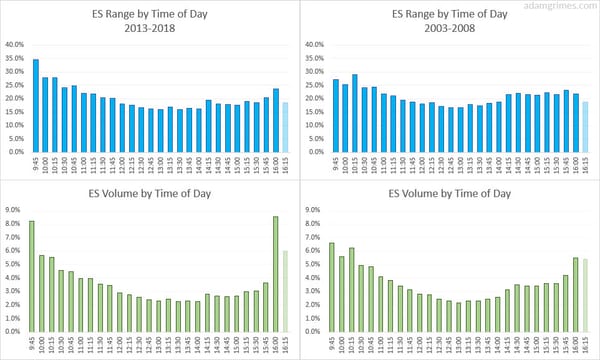Dealing with no followthrough

One of the frustrating things about current market action is that very few setups have good followthrough. We can follow a market faithfully for weeks, wait for the best possible entry point, put on the position, put in the stop, and then... nothing. The market goes nowhere, chopping around our entry price for days with no momentum or followthrough. What's a trader to do?
Accept variability
First of all, and this is much easier to write than it is to do, we have to accept that trading results are highly variable. Even the best trading methodology or system will have flat periods and drawdowns. Intellectually, this isn't so hard to grasp, but it can be very challenging emotionally. Looking at a backtest equity curve (which is highly suspect anyway!) is one thing, but actually living through those weeks and months of flat periods can be one of the worst things that a trader has to deal with. All of our fears, doubts, and insecurities explode to life, and it's not at all unusual to see a trader spiral into depression.
Part of the solution is to remind yourself that this is normal. Trading profits don't go up in a straight line--they go up, down, sideways, backwards even, and many valid methodologies spend more time losing money than making money, even if they make a lot of money in the end. Reminding yourself that this is normal doesn't solve the emotional problem, but a steady, gentle voice from your rational side can certainly help.
Manage the emotions
Think about that line above: the important word is "manage". You are not going to eliminate, or perhaps even reduce, the emotions you feel. Over time, most traders work toward an emotional state of peace and balance, but this isn't essential to trading. (For some traders, violent emotions are a key part of why they are successful!) What is essential is that you keep your emotions in check. You can be angry, frustrated, scared, etc., but you cannot let your emotions cause you to make mistakes.
That's the "secret" to dealing with trading emotions: you're going to experience emotions, but you they can't dictate your behavior. If you want to double up, ignore a stop, get right back in a losing trade, take trades that don't have good patterns, or stop doing your homework, that is a sure sign that your emotions are influencing your trading behavior. Good traders learn to recognize those warning signs, and they learn to not react to emotions.
It's also worth pointing out that you probably have very limited power to "reason" yourself out of emotions. You can't say "this emotion doesn't make any sense or it's not useful, so I'm going to stop feeling it." Emotions and rational thought almost exist in parallel universes with not that much contact! You have your emotional inner life, and you have your rational inner life. To some degree, good self talk can set you on the path to managing emotions, and this is, in fact, what I was suggesting with the "accept variability" stage, but most emotions have to be dealt with on their own level in time. You can, however, minimize the impact of your emotions on your trading. You can... and if you can't, you probably can't be a trader.
Have a plan
So much of this goes back to having a plan and knowing what kind of trader you are. One of the frustrating things is that something is always working. If you're a breakout trader, you've seen very poor trade performance, but those mean reversion guys are doing pretty well, aren't they? Those guys selling options premium? Raking it in every week or every month. It's very easy to jump ship and try different trading approaches, but be careful doing this. There's a very good chance that the market regime will change about the time you start doing something new, and then that something new will stop working.
Good traders can be one trick ponies (contrary to some marketing that suggests otherwise), but most good traders have a pretty big bag of tricks. There's nothing wrong with expanding that bag of tricks and learning new ways to trade, but you must do it in a planned and disciplined way, not being pushed around by your emotional reactions to frustrating periods in your own trading. A good trading plan will have both specific setups and a template for your own growth and development. How and when will you learn new ways to trade or new markets? What will you and what won't you do? How much of your time is split between research and execution? How do you plan personally and financially for the uncertainty of trading income? These are all important questions that should be addressed before you start trading.
Practical tips: maybe your plan needs some adjustment?
Depending on your trading style, some of these things might point the way to better profits in markets with little followthrough:
- Adjust your frequency of entry. This could mean taking fewer entries on stronger patterns, or perhaps taking more entries but getting out quicker if wrong.
- Use a profit target and/or take more (or all) of the trade off at the target. Yes, there will still be times the market doesn't get to your target, but expecting extended "trend-following" style moves in choppy markets can be very frustrating. Look to hit singles, not home runs.
- Reduce trading size.
- Increase size of stops (distance from entry).
- Trade higher timeframes (which will almost certainly result in both reducing trading size and increasing size of stops.)
- DO NOT trade lower timeframes.
- Look at a new asset class, but don't abandon your area of expertise.
These market conditions are not completely unprecedented; volatility will almost certainly return, but we don't know when. It might be today, or it might be five years from now. If you're struggling in this environment, it's a good chance to work on your trading skills and methodology, and we are fortunate to have a challenging market environment in which to do this work. Difficult conditions can lead to growth. Manage the emotions; avoid mistakes, and welcome the growth.



